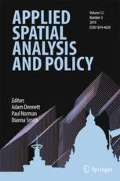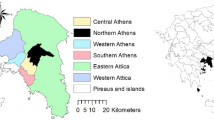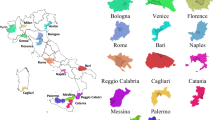Abstract
Metropolitan regions in Europe experienced intense demographic change from accelerated population expansion sustained by high fertility and immigration to zero (or negative) growth and aging. Such transformations are particularly complex in Southern Europe and lead to a shift from the impressive urban growth driven by industrialization to a more recent de-concentration of inner cities and scattered metropolitan expansion. Based on long-term population data, the present study assumes that urban expansion and demographic trends in Southern Europe no longer follow sequential phases of growth and decline, being characterized by non-linear urban expansion and distinctive demographic trends. Such hypothesis was tested considering a complete urban cycle and the associated population trends over a sufficiently long time interval (1848–2011) in metropolitan Athens, Greece. Population increase was assessed through the analysis of long-term census data made available on a district scale. Such analysis provided information on the spatial distribution of resident population and allowed identification of multiple expansion waves only partly aligned with predictions of the urban cycle model. The complex interplay between long-term fertility-mortality dynamics and short-term migration trends in Athens justifies deviations from model’s predictions. A long-term analysis of population trends at local scale contributes to re-contextualize urban cycles within the (more general) debate on demographic transitions, evidencing together the multi-scalar influence of population dynamics on metropolitan expansion and the importance of a historical analysis of population growth from the beginning of the modern urban experience.






Similar content being viewed by others
References
Adveev, A., Eremenko, T., Festy, P., Gaymu, J., Le Bouteillec, N., & Springer, S. (2011). Populations and demographic trends of European countries, 1980-2010. Population, 66(1), 9–129.
Allen, J., Barlow, J., Leal, J., Maloutas, T., & Padovani, L. (2004). Housing in southern Europe. London: Blackwell.
Angel, S., Parent, J., Civco, D. L., Blei, A., & Potere, D. (2011). The dimensions of global urban expansion: Estimates and projections for all countries, 2000–2050. Progress in Planning, 75, 53–107.
Arapoglou, V. P., & Sayas, J. (2009). New facets of urban segregation in southern Europe. European Urban and Regional Studies, 16(4), 345–362.
Ascolani, A., & Baldini, R. (2007). Testing a new approach in measuring spatial concentration of population: Italy, 1971-2001. Genus, 63(3–4), 127–150.
Bell, M. (2015). Demography, time and space. Journal of Population Research, 32(3–4), 173–186.
Berry, B. J. L. (1976). Urbanization and counterurbanization. New York: Sage.
Bocquier, P., & Brée, S. (2018). A regional perspective on the economic determinants of urban transition in 19th-century France. Demographic Research, 38(50), 1535–1576.
Bocquier, P., & Costa, R. (2015). Which transition come first? Urban and demographic transitions in Belgium and Sweden. Demographic Research, 33, 1297–1332.
Bonifazi, C., & Heins, F. (2003). Testing the differential urbanisation model for Italy. Tijdschrift voor Economische en Sociale Geografie, 94, 23–37.
Carlucci, M., Grigoriadis, E., Rontos, K., & Salvati, L. (2017). Revisiting an hegemonic concept: Long term ‘Mediterranean Urbanization’ in between city re-polarization and metropolitan decline. Applied Spatial Analysis and Policy, 10, 347–362.
Ceccarelli, T., Bajocco, S., Perini, L., & Salvati, L. (2014). Urbanisation and land take of high quality agricultural soils - exploring Long-term land use changes and land capability in northern Italy. International Journal of Environmental Research, 8, 181–192.
Champion, T., & Hugo, G. (2004). New forms of urbanization. Ashgate, Aldershot: Beyond the urban-rural dichotomy.
Chorianopoulos, I., Pagonis, T., Koukoulas, S., & Drymoniti, S. (2010). Planning, competitiveness and sprawl in the Mediterranean city: The case of Athens. Cities, 27, 249–259.
Cohen, B. (2006). Urbanization in developing countries: Current trends, future projections, and key challenges for sustainability. Technology in Society, 28, 63–80.
Colantoni, A., Grigoriadis, E., Sateriano, A., Venanzoni, G., & Salvati, L. (2016). Cities as selective land predators? A lesson on urban growth, (un)effective planning and sprawl containment. Science of the Total Environment, 545, 329–339.
Coleman, D. A. (2005). Population prospects and problems in Europe. Genus, 61(3–4), 413–464.
Couch, C., Petschel-Held, G., & Leontidou, L. (2007). Urban sprawl in Europe: Landscapes, land-use change and policy. Oxford: Blackwell.
Courgeau, D. (1992). Migration nette et densité: la France de 1954 à 1990. Population, 47(2), 462–467.
Cuadrado-Ciuraneta, S., Durà-Guimerà, A., & Salvati, L. (2017). Not only tourism: Unravelling suburbanization, second-home expansion and "rural" sprawl in Catalonia, Spain. Urban Geography, 38, 66–89.
Cuberes, D. (2011). Sequential city growth: Empirical evidence. Journal of Urban Economics, 69(2), 229–239.
De Rosa, S., & Salvati, L. (2016). Beyond a ‘side street story’? Naples from spontaneous centrality to entropic polycentricism, towards a ‘crisis city’. Cities, 51, 74–83.
Di Feliciantonio, C., & Salvati, L. (2015). ‘Southern’ alternatives of urban diffusion: Investigating settlement characteristics and socioeconomic patterns in three Mediterranean regions. Tijdschrift voor Economische en Sociale Geografie, 106, 453–470.
Dura-Guimera, A. (2003). Population deconcentration and social restructuring in Barcelona, a European Mediterranean city. Cities, 20(6), 387–394.
European Environment Agency. (2006). Urban sprawl in Europe – The ignored challenge. Copenhagen, EEA Report no. 10.
Gans, P. (2017). Urban population development in Germany (2000-2014): The contribution of migration by age and citizenship to Reurbanisation. Comparative Population Studies, 42, 319–352.
Gospodini, A. (2009). Post-industrial trajectories of Mediterranean European cities: The case of post-Olympics Athens. Urban Studies, 46(5–6), 1157–1186.
Gross, E. (1954). The role of density as a factor in metropolitan growth in the United States of America. Population Studies, 8(2), 113–120.
Haase, A., Kabisch, S., Steinführer, A., Bouzarovski, S., Hall, R., & Ogden, P. (2010). Emergent spaces of reurbanisation: Exploring the demographic dimension of inner-city residential change in a European setting. Population, Space and Place, 16(5), 443–463.
Hall, P. (2009). Looking backward, looking forward: The city region of the mid-21st century. Regional Studies, 43(6), 803–817.
Henrie, C. J., & Plane, D. A. (2008). Exodus from the California core: Using demographic effectiveness and migration impact measures to examine population redistribution within the western United States. Population Research and Policy Review, 27(1), 43–64.
Hionidou, V. (1995). The demographic system of a Mediterranean island: Mykonos, Greece 1859 1959. International Journal of Population Geography, 1(2), 125–146.
Jennissen, R., Van Der Gaag, N., & Van Wissen, L. (2006). Searching for similar international migration trends across countries in Europe. Genus, 62(2), 37–64.
Johnson, K. M., Nucci, A., & Long, L. (2005). Population trends in metropolitan and nonmetropolitan America: Selective Deconcentration and the rural rebound. Population Research and Policy Review, 24(5), 527–542.
Kabisch, N., & Haase, D. (2011). Diversifying European agglomerations: Evidence of urban population trends for the 21st century. Population, Space and Place, 17(3), 236–253.
Kalantari, Z., Ferreira, C. S. S., Keesstra, S., & Destouni, G. (2018). Ecosystem-based solutions for flood-drought risk mitigation in vulnerable urbanizing parts of East-Africa. Current Opinion in Environmental Science & Health, 5, 73–78.
Kalogirou, S., Papadakis, M., & Tsimbos, C. (2011). Final report on “Population Projections by age and sex for Local Authorities in the Region of Attica: 2001–2021”, Master Plan of Athens/Attica 2021, Organization of Planning and Environmental Protection of Athens (web: http://gisc.gr/en/publications/
Kasanko, M., Barredo, J. I., Lavalle, C., McCormick, N., Demicheli, L., Sagris, V., & Brezger, A. (2006). Are European cities becoming dispersed? A comparative analysis of fifteen European urban areas. Landscape and Urban Planning, 77, 111–130.
Keesstra, S., Mol, G., de Leeuw, J., Okx, J., de Cleen, M., & Visser, S. (2018). Soil-related sustainable development goals: Four concepts to make land degradation neutrality and restoration work. Land, 7(4), 133.
Klaassen, L. H., Molle, W. T. M., & Paelinck, J. H. P. (1981). Dynamics of urban development. Aldershot: Gower.
Kotzamanis, V. (1997). Athens 1848-1995. The demographic emergence of a metropolis. The Greek Review of Social Research, 92(93), 3–30.
Kroll, F., & Kabisch, N. (2012). The relation of diverging urban growth processes and demographic change along an urban–rural gradient. Population, Space and Place, 18(3), 260–276.
Lee, R. (2003). The demographic transition: Three centuries of fundamental change. The Journal of Econonomic Persperctives, 17(4), 1667–1190.
Leontidou, L. (1996). Alternatives to modernism in (southern) urban theory: Exploring in between spaces. International Journal of Urban and Regional Research, 20(2), 180–197.
Lerch, M. (2014). The role of migration in the urban transition: A demonstration from Albania. Demography, 51(4), 1527–1550.
Livi-Bacci, M. (2015). What we can and cannot learn from the history of world population. Population Studies, 69(1), S21–S28.
Longhi, C., & Musolesi, A. (2007). European cities in the process of economic integration: Towards structural convergence. Annals of Regional Science, 41, 333–351.
Maloutas, T. (2007). Segregation, social polarization and immigration in Athens during the 1990s: Theoretical expectations and contextual difference. International Journal of Urban and Regional Research, 31(4), 733–758.
Michielin, F. (2004). Lowest low fertility in an urban context: The role of migration in Turin, Italy. Population, Space and Place, 10(4), 331–347.
Morelli, V., Rontos, K., & Salvati, L. (2014). Between suburbanisation and re-urbanisation? Revisiting the urban life cycle in a Mediterranean Compact City. Urban Research and Practice, 7(1), 74–88.
Munafò, M., Salvati, L., & Zitti, M. (2013). Estimating soil sealing at country scale – Italy as a case study. Ecological Indicators, 26, 36–43.
Panori, A., Psycharis, Y., & Ballas, D. (2018). Spatial segregation and migration in the city of Athens: Investigating the evolution of urban socio-spatial immigrant structures. Population, Space and Place, e2209.
Petsimeris, P., & Tsoulouvis, L. (1997). Current trends and prospects of future change in the Greek urban system. Rivista Geografica Italiana, 104, 421–443.
Phelps, N. A., Parsons, N., Ballas, D., & Dowling, A. (2006). Post-suburban Europe: Planning and politics at the margins of Europe’s capital cities. Basingstoke: Palgrave Macmillan.
Pili, S., Grigoriadis, E., Carlucci, M., Clemente, M., & Salvati, L. (2017). Towards sustainable growth? A multi-criteria assessment of (changing) urban forms. Ecological Indicators, 76, 71–80.
Rees, P., Bell, M., Kupiszewski, M., Kupiszewska, D., Ueffing, P., Bernard, A., Edwards, E. C., & Stillwell, J. (2017). The impact of internal migration on population redistribution: An international comparison. Population, Space and Place, 23(6), e2036.
Rontos, K., Grigoriadis, S., Sateriano, A., Syrmali, M., Vavouras, I., & Salvati, L. (2016). Lost in protest, found in segregation: Divided cities in the light of the 2015 ‘Oki’ referendum in Greece. City, Culture and Society, 7, 139–148.
Salvati, L., & Carlucci, M. (2016). In-between stability and subtle changes: Urban growth, population structure, and the City life cycle in Rome. Population, Space and Place, 22(3), 216–227.
Salvati, L., & Carlucci, M. (2017). Urban growth, population, and recession: Unveiling multiple spatial patterns of demographic indicators in a Mediterranean City. Population, Space and Place, 23(8), e2079.
Salvati, L., & Serra, P. (2016). Estimating rapidity of change in complex urban systems: A multidimensional, local-scale approach. Geographical Analysis, 48, 132–156.
Salvati, L., Gargiulo, V., Rontos, K., & Sabbi, A. (2013). Latent exurban development: City expansion along the rural-to-urban gradient in growing and declining regions of southern Europe. Urban Geography, 34, 376–394.
Scheuer, S., Haase, D., & Volk, M. (2016). On the Nexus of the spatial dynamics of global urbanization and the age of the City. PLoS One, 11(8), e0160471.
Schneider, A., & Woodcock, C. E. (2008). Compact, dispersed, fragmented, extensive? A comparison of urban growth in twenty-five global cities using remotely sensed data, pattern metrics and census information. Urban Studies, 45(3), 659–692.
Schwarz, N., Haase, D., & Seppelt, R. (2010). Omnipresent sprawl? A review of urban simulation models with respect to urban shrinkage. Environment and Planning B, 37, 265–283.
Scott, A. J. (2001). Globalization and the rise of city-regions. European Planning Studies, 9(7), 813–826.
Serra, P., Vera, A., Tulla, A. F., & Salvati, L. (2014). Beyond urban-rural dichotomy: Exploring socioeconomic and land-use processes of change in Spain (1991-2011). Applied Geography, 55, 71–81.
Strozza, S., Benassi, F., Ferrara, R., & Gallo, G. (2016). Recent demographic trends in the major Italian urban agglomerations: The role of foreigners. Spatial Demography, 4, 39–70.
Turok, I., & Mykhnenko, V. (2007). The trajectories of European cities, 1960-2005. Cities, 24(3), 165–182.
van den Berg, L., Drewett, L., & Klaassen, L. H. (1982). Urban Europe: A study of growth and decline. Oxford: Pergamon Press.
Véron, J. (2008). Economic, social, and environmental challenges in world urbanization. Mondes en développement, 2, 39–52.
Yousefi, S., Moradi, H. R., Keesstra, S., Pourghasemi, H. R., Navratil, O., & Hooke, J. (2019). Effects of urbanization on river morphology of the Talar River, Mazandarn Province, Iran. Geocarto International, 34(3), 276–292.
Zambon, I., Serra, P., Sauri, D., Carlucci, M., & Salvati, L. (2017). Beyond the ‘Mediterranean City’: Socioeconomic disparities and urban sprawl in three Southern European cities. Geographiska Annaler B, 99, 319–337.
Zambon, I., Benedetti, A., Ferrara, C., & Salvati, L. (2018). Soil matters? A multivariate analysis of socioeconomic constraints to urban expansion in Mediterranean Europe. Ecological Economics, 146, 173–183.
Zitti, M., Ferrara, C., Perini, L., Carlucci, M., & Salvati, L. (2015). Long-term urban growth and land use efficiency in southern Europe: Implications for sustainable land management. Sustainability, 7, 3359–3385.
Funding
This study was funded the Ministry of Education, Youth and Sports of CR within the National Sustainability Program I (NPU I), grant number LO1415.
Author information
Authors and Affiliations
Corresponding author
Ethics declarations
Conflict of Interest
The authors declare that they have no conflict of interest.
Additional information
Publisher’s Note
Springer Nature remains neutral with regard to jurisdictional claims in published maps and institutional affiliations.
Rights and permissions
About this article
Cite this article
Benassi, F., Salvati, L. Urban Cycles and Long-Term Population Trends in a Southern European City: A Demographic Outlook. Appl. Spatial Analysis 13, 777–803 (2020). https://doi.org/10.1007/s12061-019-09328-0
Received:
Accepted:
Published:
Issue Date:
DOI: https://doi.org/10.1007/s12061-019-09328-0




